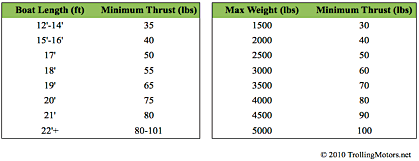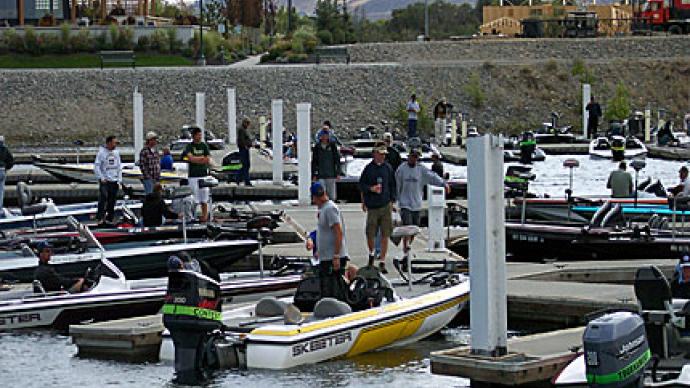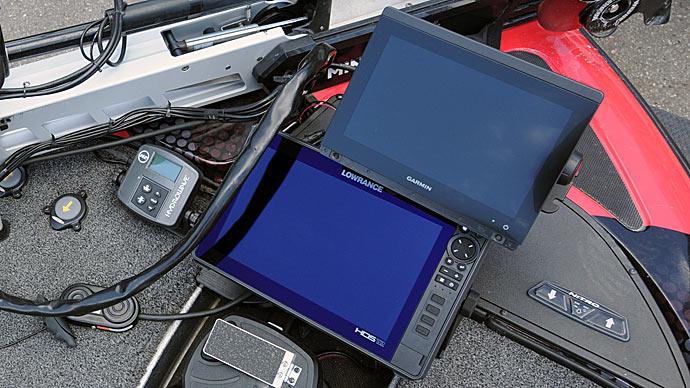There are a lot of factors to consider when choosing a trolling motor, and if you're unfamiliar with the terminology and jargon it can be downright overwhelming! Mounting location, control type, thrust and numerous high-tech options are just a few of the things you'll have to consider. Worse yet, selecting the wrong motor can result in sluggish on-the-water performance or other frustrating complications. This article covers the critical issues you need to understand in order to confidently select the right trolling motor for your boat and fishing style.
Thrust
The most commonly asked question regarding trolling motors is "How much thrust do I need for my boat?" The issue of thrust is one of, if not THE most important decision you'll make when selecting a new motor. Why? Without ample thrust to move your boat, you'll experience sluggish acceleration and poor maneuvering out on the water. At the same time, you don't want to spend extra money on unnecessary power that you don't need.
The most important determinant of how much thrust you'll need is boat weight. While this information is not always known, it offers best chances of determining the right amount of thrust for your boat. When calculating boat weight, make sure to account for a fully loaded boat - people, equipment, etc. If you're unsure of your boat's approximate weight, the next best metric to judge required thrust is boat length. While not a perfect indicator, this will provide a pretty good idea of the thrust range needed.
The chart below is a good guide for required thrust based on boat length and weight. Again, use boat weight as the first determinant if you know it.

The thrust recommendations listed above should be considered minimums. If you spend a lot of time fishing in rough waters, strong currents or windy conditions you'll want to add at least ten pounds of thrust to the amount recommend above.
Mounting Location
Nearly all trolling motors are either mounted on the bow or the transom. Both have their advantages and disadvantages, but this is usually one of the easier choices when selecting a motor. While not always the case, you'll usually have a pretty clear idea of which one will work best given your boat and needs.
Transom Mount Motors
Transom mount motors are mounted on the rear transom of the boat, and are usually operated by hand. They are characterized by a number of attributes.
Most Affordable: Transom motors are the most affordable option. Entry-level transom motors can be purchased for under $200; while bow mounted motors usually start in the $300 to $400 range.
Ideal for Small Boats: For small and open hull boats, transom motors are usually the best choice. The transom is often the only available mounting option in smaller boats without a flat bow, and the motor can be easily operated while sitting.
Less Precise Steering: While not difficult to steer, transom motors don't offer the level of steering precision available with bow mount motors. Bow mount motors pull the boat through the water, which allows for more precise steering and boat control compared to steering from the rear of the boat.
Limited Options: If you're looking for advanced options like AutoPilot and Wireless motor control, you'll have a hard time finding them on transom mount motors. Most high-tech features are usually found exclusively on upper-end bow mount motors.
Bow Mount Motors
Bow motors are mounted on the front of the boat, require a flat bow for installation, and have a number of unique features.
Hands-Free Operation: Most bow motors use a foot pedal to control the motor speed and direction, allowing you keep your hands free for fishing.
More Options: Most of the high-end options such as AutoPilot and wireless control are available exclusively on bow mount motors.
Precise Steering: Bow mount motors pull the boat through the water, which allows for more responsive and precise steering compared to transom motors, which push from behind.
Cluttered Deck: Unless a wireless device is used, most bow motor pedals have a cord that runs between the pedal and motor, which can often clutter the deck of the boat.
More Expensive: Bow mount motors tend to be more expensive than transom mount motors. Feature for feature, they cost more than transom mount motors and start at a significantly higher price as well.
Shaft Length
Shaft length refers to the length of the trolling motor shaft, measured from where the shaft begins below the motor head down to the propeller. Most motors come with two or three different shaft length options, with specific lengths varying based on the type of motor. Selecting the right shaft length is important. A shaft that is too short won't be adequately submerged and will result in inadequate power and thrust. Too long of a shaft will be more likely to hit bottom and may prevent you from navigating shallow waters. Recommended shaft lengths vary slightly between bow mount and transom mount motors.
Transom Mount Shaft Length
Transom mount trolling motors should have approximate twenty to twenty-five inches of the shaft submerged when the boat is setting in the water. To calculate, measure the distance between the transom and the water, and then add the twenty to twenty-five inch submersion factor to give you an approximate required shaft length. For example, if the distance from the transom mount to the water is sixteen inches, you would want a shaft length in the range of thirty-six to forty-one inches.
Bow Mount Shaft Length
The process for determining bow mount motor shaft length is similar, but with a slightly different submersion factor. As the bow of the boat will move up and down with waves more than the transom will, the submersion factor is a little larger at twenty-five to thirty inches. To calculate appropriate shaft length, measure the distance between the bow of the boat and the water, then add the submersion factor for the appropriate shaft length. For example, if the distance from the bow to the water is twenty-four inches, you would want a shaft length in the range of forty-nine to fifty-four inches.
These guidelines are approximations, and don't need to be followed to the inch. If you can't find a shaft length in the range needed, it's acceptable to deviate moderately from these recommendations. Whenever in doubt, or if unable to find a shaft in the range needed, go with a longer shaft verses. a shorter one. While you can always stow your trolling motor to avoid banging up the shaft, it's much harder to remedy inadequate power due to the motor not being adequately submerged.
Control Type
There are a number of options when it comes to motor control, and it tends to be a very personal decision. There is no "best" universal choice. The method of motor control you decide on will be largely dictated by your fishing style as well as the type of motor you choose. If you fish sitting from the back of the boat, a hand controlled motor would likely work well. If you're always standing and pacing about with the rod, you'll likely want a foot or wireless control.
There are primarily three types of control options: hand control, foot control and wireless control.
With very few exceptions, transom mount motors are hand control only. The head of the motor must be manually moved by hand from the back of the boat.
Bow mount motors offer many more options and bow models exist that offer hand, foot or wireless control. While foot pedals are the most popular option for bow mount motors, wireless and even hand-controlled models are available and frequently used. Think about how you fish and how you move about the boat, and pick a control method that best fits your needs and style.
Features and Options to Consider
The trolling motor industry has seen a significant number developments and improvements in recent years. You likely won't need every bell and whistle ever offered for a motor, but there are a number of premium features that can make life on the water significantly easier:
AutoPilot: If you've ever grown tired of babysitting your motor to keep it heading on a straight course, you'll love AutoPilot. AutoPilot uses a compass to keep your motor heading in a set direction without the need to monitor it. Simply engage the AutoPilot traveling in the direction desired and relax while your AutoPilot equipped motor keeps a true, straight course. This feature is convenient when cruising shorelines, underwater shelves or heading toward a far off destination across open water. AutoPilot is available as an option with certain new motors, as well as an add-on accessory for select models.
GPS Technology: Minn Kota has made quite a splash with their new trolling technology called i-Pilot. Powered by GPS technology, the Minn Kota i-Pilot offers a number of impressive features. The "Spot Lock" feature uses satellites to keep your boat in place regardless of winds, waves or currents. If you drift away from the spot, the motor automatically activates and returns you to your original location. The "Record A Track" feature lets you record a fishing course and when finished, automatically re-trace the exact path from memory. Along with standard AutoPilot, i-Pilot also features a waterproof remote keypad from which all motor and i-Pilot features can be controlled. Currently, Minn Kota is the only company that offers GPS trolling technology. I-Pilot is available with select new models, as well as an add-on accessory.
Motor Stowing: Nearly all bow motors, and some transom motors have the ability to rotate up and stow out of the water while mounted to the boat. This is extremely convenient when transporting the boat, entering very shallow waters or traveling at high speeds with an outboard motor. When purchasing a transom mount motor, it's often worth upgrading to a nicer motor for this feature alone.
Built-in Sonar Transducer: Upper-end bow motors usually offer an optional sonar transducer built-in to the bottom of the shaft. A built-in transducer eliminates the inconvenience and unsightliness of running wires down the motor shaft. More importantly, as most built-in transducers are recessed and flush with the shaft bottom, there is little chance of snagging the transducer on a rock or stick and damaging it.
Quick Disconnect: Bow mount trolling motors are usually bolted down to the deck of a boat, and it can be time consuming and inconvenient to remove them if required. Fortunately, many trolling motors have an available quick disconnect accessory that makes removal easy. These unique mounts install directly to the deck of the boat and act as a docking bay for the trolling motor. Often using a pin or other locking device, the motor can be attached to the quick disconnect and locked into place. When the motor needs to be removed, it can be lifted cleanly away. Quick disconnects are ideal if you plan on leaving your boat unattended in a public place and are worried about theft, or if you need to remove your motor from your boat frequently.
Batteries, Run Time and Chargers
The topic of trolling motor electrical issues is a comprehensive one, and we've dedicated an entire article to it. It covers common electrical questions such as battery selection, estimating motor run time, multi-battery wiring, selecting battery chargers and more. For more information, please see Trolling Motor Electrical Issues - Batteries, Wiring and Chargers.
TrollingMotors.net focuses exclusively on trolling motors and is dedicated to educating bass fishermen through articles, videos, detailed pictures, thorough product descriptions and expert assistance. Their website includes hundreds of trolling motors, as well as educational materials and resources.




